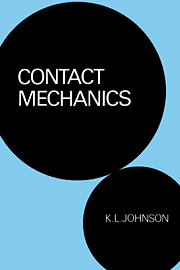Book contents
- Frontmatter
- Contents
- Preface
- 1 Motion and forces at a point of contact
- 2 Line loading of an elastic half-space
- 3 Point loading of an elastic half-space
- 4 Normal contact of elastic solids – Hertz theory
- 5 Non-Hertzian normal contact of elastic bodies
- 6 Normal contact of inelastic solids
- 7 Tangential loading and sliding contact
- 8 Rolling contact of elastic bodies
- 9 Rolling contact of inelastic bodies
- 10 Calendering and lubrication
- 11 Dynamic effects and impact
- 12 Thermoelastic contact
- 13 Rough surfaces
- Appendices
- References and author index
- Subject index
- Frontmatter
- Contents
- Preface
- 1 Motion and forces at a point of contact
- 2 Line loading of an elastic half-space
- 3 Point loading of an elastic half-space
- 4 Normal contact of elastic solids – Hertz theory
- 5 Non-Hertzian normal contact of elastic bodies
- 6 Normal contact of inelastic solids
- 7 Tangential loading and sliding contact
- 8 Rolling contact of elastic bodies
- 9 Rolling contact of inelastic bodies
- 10 Calendering and lubrication
- 11 Dynamic effects and impact
- 12 Thermoelastic contact
- 13 Rough surfaces
- Appendices
- References and author index
- Subject index
Summary
The subject of contact mechanics may be said to have started in 1882 with the publication by Heinrich Hertz of his classic paper On the contact of elastic solids. At that time Hertz was only 24, and was working as a research assistant to Helmholtz in the University of Berlin. His interest in the problem was aroused by experiments on optical interference between glass lenses. The question arose whether elastic deformation of the lenses under the action of the force holding them in contact could have a significant influence on the pattern of interference fringes. It is easy to imagine how the hypothesis of an elliptical area of contact could have been prompted by observations of interference fringes such as those shown in Fig. 4.1 (p. 86). His knowledge of electrostatic potential theory then enabled him to show, by analogy, that an ellipsoidal – Hertzian – distribution of contact pressure would produce elastic displacements in the two bodies which were compatible with the proposed elliptical area of contact.
Hertz presented his theory to the Berlin Physical Society in January 1881 when members of the audience were quick to perceive its technological importance and persuaded him to publish a second paper in a technical journal. However, developments in the theory did not appear in the literature until the beginning of this century, stimulated by engineering developments on the railways, in marine reduction gears and in the rolling contact bearing industry.
- Type
- Chapter
- Information
- Contact Mechanics , pp. ix - xiiPublisher: Cambridge University PressPrint publication year: 1985
- 1
- Cited by



